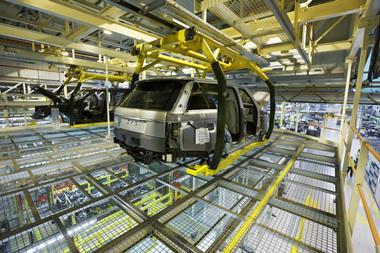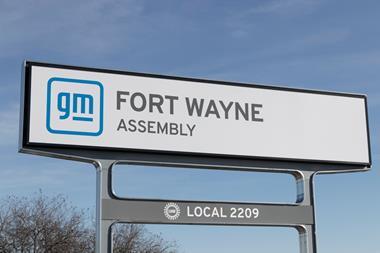
Portable systems have made high-accuracy measurement possible across all plant areas – the next step in this evolution is the integration of metrology with automation
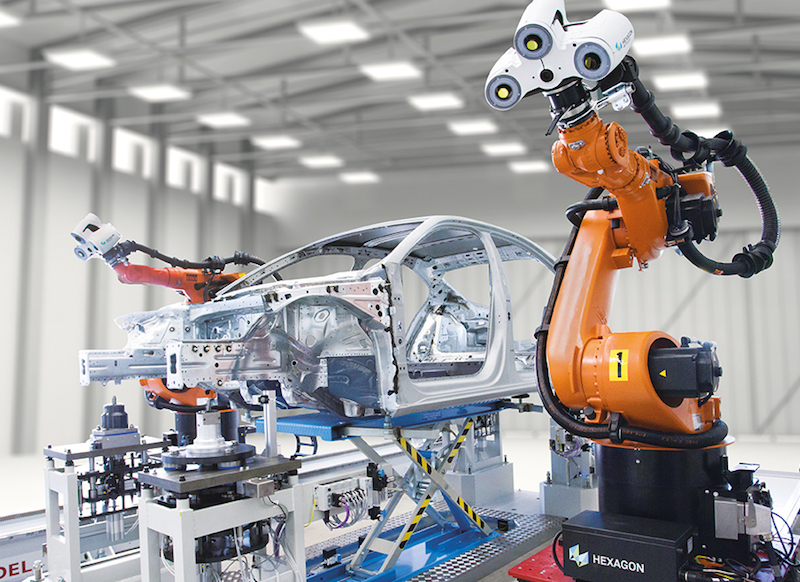 From the progressive assembly line to lean manufacturing principles, the automotive industry has always led the way in manufacturing technology. As the industry faces ever shorter design-to-production times, automotive manufacturers and suppliers have embraced industrial metrology and 3D measurement as enablers of productivity.
From the progressive assembly line to lean manufacturing principles, the automotive industry has always led the way in manufacturing technology. As the industry faces ever shorter design-to-production times, automotive manufacturers and suppliers have embraced industrial metrology and 3D measurement as enablers of productivity.
Recent trends include the move from off-line quality inspection to near-line or in-line measurement techniques, enabling higher sampling rates and faster inspection times. The most advanced automotive OEMs are working to automate inspection and integrate metrology data with product lifecycle management systems, statistical process control and supply chain management software. This actionable information helps inform decision making and find new ways to reduce ramp up times, minimise part rejection and improve the performance of cars, vans, trucks and other vehicles.
Today, off-line and near-the-line high-accuracy dimensional inspection in the automotive sheet metal and car-body manufacturing process remains mostly the preserve of fix-installed stationary coordinate measuring machines (CMMs). Now portable measurement systems like 3D laser trackers and articulated measuring arms are that bringing accuracy and precision to every area of vehicle production plants.
The next step in this ongoing evolution will be the integration of measurement and automation. Automated in-line white light scanning systems are already enabling entire car bodies to be measured in minutes, and virtual assembly techniques minimise rework and scrap in the closures department. This is the future of automotive manufacturing.
The changing face of automotive metrology
In years past, automotive manufacturers have been forced to choose between very different paradigms in the search to improve the quality, shorten design-to-launch times and better manage the vital production ramp up period in those critical high-demand months following a new launch.
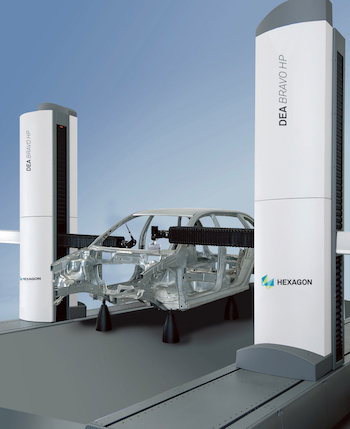
On one side were proven CMM technologies and methods that were mostly used in the measuring room and near-the-line. These were mostly applied to sample parts for measurement, analysis and problem solving.On the other side were in-line process control systems that needed to work quickly to support line cycle times.
These however offered limited 3D metrology reliability and lacked the dimensional information required to solve a problem once a quality concern had been raised. In reality, most OEMs and suppliers over the last decade decided on a mixed dimensional control strategy involving both traditional measurement systems and others that supported in-line process control systems. In some cases this led to an overlap that created efficiency challenges and unnecessarily iterative processes.
In parallel to these developments, the industry saw the development of additional metrology systems and technologies such as non-contact optical scanners that complemented traditional probing CMMs.
These new non-contact scanners were first used in manual configurations before maturing into semi-automated measuring cells, proving highly useful in various automotive industry applications including prototyping, dies, sheet metal stampings and closure measurements. The industry has also seen a definite shift in approach to quality control in serial manufacturing.
Process innovations and developments in metrology equipment that have moved inspections out of the quality room and progressively closer to the line have resulted in a reduction in the time taken to collect data, obtain information and act to correct issues. Many of these changes are fuelled by innovations on the software side which help deal with the large amounts of data created and put those to best use.
Bringing big data metrology to the bodyshop

Hexagon Metrology has played a key role in developments within automotive manufacturing to date, and the business remains one of the foremost forces driving innovation in the industry. It was its investment in research and development that yielded the new technologies that first moved measurement from the quality room to the point of production and then brought metrology data into the wider factory workflow.
Recent acquisitions – including CAD/CAM specialists Vero Software and Forming Technologies Inc and statistical process control expert Q-DAS – have further expanded the business’ offering into broader manufacturing technologies.
This drive for innovation has shifted the business’ expertise and focus over the years. It now encompasses a vision for a more integrated form of industrial manufacturing, one that makes the most of the possibilities of information technology solutions that improve quality and productivity across entire industry workflows.
To reflect this evolution, Hexagon Metrology was last year rebranded as Hexagon Manufacturing Intelligence. This new public face is all about showing how Hexagon’s industrial metrology expertise has been redefined in recent years in terms of what they’ve identified as “sensing, thinking and acting”.
This refers to the integrated collection, analysis and active use of measurement data, which has become a focus of the business’ innovation within the metrology space. This holistic approach has the potential to give users the confidence to increase production speed and accelerate productivity while simultaneously enhancing product quality.
360° SIMS - Through the line and beyondOne of Hexagon’s most recent industrial solutions stands out as an attempt to solve a long-standing problem that has limited automotive manufacturing efficiency.
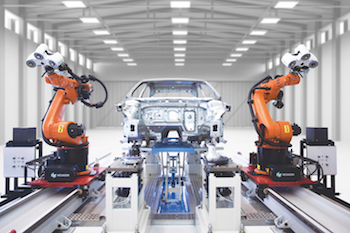 360° SIMS dual robot cell configuration employs 7-axis sliders to give robots access to all critical areas
360° SIMS dual robot cell configuration employs 7-axis sliders to give robots access to all critical areasAs industry OEMs and suppliers have been unable to fully integrate the latest metrology technologies within a single in-line workflow, a solution that combined speed, reliability and advanced data capture capabilities would have the potential to redefine the sector.
The 360° SIMS system has been developed and designed for just this purpose. An automated 3D metrology and process control system, it is suitable for use either in-line or near the line, as a line bypass or in advanced measuring centres.
The system’s fusing of innovative 3D area-measurement sensors mounted on industrial robots powered by advanced software has the capacity to allow customers to develop new, more efficient business processes.
It’s a fast, rich and actionable solution that enables automotive OEMs and suppliers to apply fully-automated dimensional quality processes for sheet metal and body assembly inspections.
With 360° SIMS, both production and quality personnel gain near real-time access to full surface and geometry inspection as well as critical feature and point measurements – all directly from the shop floor.
This is a system that innovatively handles several long-standing challenges that have faced metrology providers attempting to deliver in-line and fully automated solutions. These include the capacity to measure up to 100 percent of production parts and assemblies across 24/7 operation within demanding production environments, while fully integrating with line automation and control architecture fully in step with cycle time. These were challenges to which Hexagon were keen to apply their broad technology base and application know how, and the result is a system with the potential to transform the category by integrating metrology with automation and creating an avenue for fast, rich and actionable metrology-based process control.
The 360° SIMS dual robot cell configuration (pictured) employs 7-axis sliders to give the robots, which carry optical area sensors, access to all critical areas of a car body. Each sensor position is designed to capture an area of up to 50x50 cm, and the system integrates 3D reconstruction and 2D greyscale imagery processing.
 360° SIMS Cell automatically measuring all closure types
360° SIMS Cell automatically measuring all closure typesOnce data is captured it is immediately downloaded and processed. The 360° SIMS software crunches the huge amount of optical data captured into 3D point clouds and other dimensional data, accurately measuring geometries using subpixel technology. This is compared to the CAD design intent or a functional master part. The system then streams measurement results into the operator interface to support the timely handling of any potential quality issues.
In addition, a more detailed 3D colour map report is automatically produced and made available for further root-cause analysis. The richness of the measurements and the flexible inspection routines provide excellent support during part development, approval for production, launch and ongoing production process control stages.
The 360° SIMS near-the-line cell (pictured) is designed to support full measurement of front and rear doors, boots and bonnets, lift gates and fenders.
With this and other cell designs, parts from multiple vehicle programmes can be inspected in an in-line, near line or measuring centre configuration. As can be seen in this cell, the closure parts are fixed on a turntable, allowing the measuring robot to reach the exterior class A surface, the inner side assembly, window channel, hemline, hinges and other critical areas.
The system’s operator gets a constant update about the measurement progress and results are available a short time after the data acquisition is complete.
Once again, the results offer post-measurement flexibility not commonly available in traditional CMM and process control stations. The data model and tools allow users to further analyse the information collected, add points, cut cross sections, apply secondary local alignments and much more.
Marrying sensing technology with powerful softwareHexagon’s area measurement technology combined with the 360° SIMS software results in a variety of powerful analysis tools including rich color maps, visual SPC, comparisons, trend charts for large data sets and patent-pending video-of-the-day reports. Analysis of measurement results such as surface geometries, edge lines, character lines and cross sections makes it easier to understand the main causes of sheet metal part deformations and any quality issues with assemblies.
“Our objective was to reach into the production environment and combine our metrology capabilities with the inline process control methodologies and new software strengths,” explained Tal Vagman, Director of Product Strategy at Hexagon Manufacturing Intelligence.
“The 360° SIMS offering today includes a growing software portion designed to support emerging needs in quality assurance and dimensional process control. We intend to further support the combination of big data colour map and point-based quality evaluation as well as data interfaces for factory SPC systems and reporting”.
 3D measurement of a BIW with colour map
3D measurement of a BIW with colour mapThe system functionality and benefits extend beyond the boundaries of the cell and the single inspected part; the 360° SIMS system also offers multi-part process control analysis and reporting functionality, as well as integration to the world-renowned Q-DAS SPC software and other functions designed to support smart corrective actions.
For example, once the body-in-white and closure parts have been automatically measured in their respective lines, it is now possible to use the software tools to load these separate measurement results into the shared car coordinate system.
In this virtual assembly environment we can visualise the point cloud of all parts, compare them to CAD, inspect points and conduct studies focused on predicting assembly quality and fit and finish.
One of benefits of using this area measurement technology is the ability to conduct virtual flush and gap or seal gap analyses on the body and closure assembly. This can help focus quality efforts on the most important areas.
“360° SIMS installations are designed to be adapted to their respective environment and target industry applications mainly in the automotive body shop”, says Giacomo Barila, Product Line Manager for Automated Solutions at Hexagon Manufacturing Intelligence.
“Analysis of the technology implementations shows that customers are noting significant improvements in efficiency, faster problem resolutions and higher usability of the measurement data”.
https://youtu.be/4OczE7xMbBU
Apart from these and other capital and operational savings, customer also expect this new solution to offer greater flexibility in measuring multiple models and allowing for easy product updates with the ever shortening times between new models.
Overall, it’s another step towards the digital factory of tomorrow, and integrates Hexagon Manufacturing Intelligence’s most powerful technology offerings within a cohesive whole that can meet customer needs.
 360° SIMS Automotive Solutions MapTo reflect the unique nature of the 360° SIMS system and the various possible configurations in which it can be delivered to users with varying needs, Hexagon have produced the 360° SIMS Automotive Solutions Map. The map constitutes a full guide to what’s achievable with a 360° SIMS system, and which specific configurations are likely suit particular use cases.
360° SIMS Automotive Solutions MapTo reflect the unique nature of the 360° SIMS system and the various possible configurations in which it can be delivered to users with varying needs, Hexagon have produced the 360° SIMS Automotive Solutions Map. The map constitutes a full guide to what’s achievable with a 360° SIMS system, and which specific configurations are likely suit particular use cases.
The 360° SIMS Automotive Solutions Map is available to download for free.





























